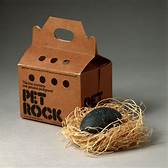When Did Pet Rocks Come Out?
In the world of quirky and unconventional pets, pet rocks hold a unique place in history. The craze for these inanimate companions swept across the United States and beyond in the early 1970s, capturing the fascination of people from all walks of life.

The Origins of Pet Rocks
The idea of marketing rocks as pets is attributed to Gary Dahl, an advertising executive from California. Dahl was inspired by a conversation he had with friends about the benefits of owning a "no-care" pet. He realized that rocks fit that description perfectly.
In 1975, Dahl decided to take his idea to the next level. He purchased a large quantity of smooth, oval-shaped rocks from a Mexican beach and meticulously packaged them in cardboard boxes. Each box included the rock, a carrying case, and an instruction manual filled with humorous and tongue-in-cheek advice on caring for a pet rock.
The Pet Rock Phenomenon Takes Off
Dahl's pet rocks were an instant success. He initially sold them locally at gift shops and flea markets, but soon the demand exploded. Major retailers like Sears and JCPenney began stocking the rocks, and they quickly became a nationwide sensation.
The popularity of pet rocks can be attributed to several factors. First, they were a novelty item, something that had never been seen before. Second, they were affordable and easy to care for, appealing to people who didn't have the time or resources to own a traditional pet. Third, Dahl's clever marketing campaign, which included appearances on popular talk shows and humorous advertisements, helped to generate buzz around the product.
The Legacy of Pet Rocks
The pet rock craze was short-lived, reaching its peak in 1975 and declining rapidly in the following years. However, the impact of this phenomenon went beyond the brief period of its popularity.
Pet rocks became a symbol of the 1970s, a time of economic and social change. They represented a departure from traditional notions of pet ownership and reflected the growing desire for novelty and easy-going companionship.
The success of pet rocks also inspired other entrepreneurs to create and market unusual pets, such as glow-in-the-dark worms and invisible goldfish. While these products didn't achieve the same level of success as pet rocks, they demonstrated the enduring appeal of the novelty pet market.
Today, pet rocks remain a cultural artifact of the 1970s, reminding us of a time when a simple rock could bring joy and laughter to people of all ages.
Declaration: All article resources on this website, unless otherwise specified or labeled, are collected from online resources. If the content on this website infringes on the legitimate rights and interests of the original author, you can contact this website to delete it.





